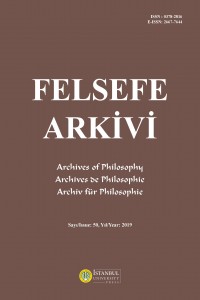Abstract
Critique of the Power of Judgment is the third work of Kant’s critical philosophy. Kant states that he has put this work on paper to complement his critical philosophy. This statement of completion constitutes the transition that is required between the theoretical and practical areas of philosophy. According to Kant, transition from the theortical area, or natural area to the practical area, or the area of freedom is not possible. Moreover, principals in the area of freedom need to be realised in the area of nature. Kant has presented a system that establishes art as the bridge from the area of freedom to the area of nature. With regard to this system, genius is the skill that provides the rules for art through nature and as one definition of beautiful in Critique of the Power of Judgment, Kant identifies beautiful as the transition of aesthetical ideas thorough genius. This transition occurs as a result of the judgment of taste by means of the free play of imagination and understanding. My aim in this study is to clarify how imagination that is not limited by understanding widens up and is presented as [non-conceptional] aestethical ideas through art. In order to put forth this representation with all its clarity, I will try to elucidate the meaning of the transition from the practical area of philosophy to its theoretical area, which is crucial according to Kant. In this contect, I wil emphasize the nature of judgments of taste, relation of nature-art, classification of fine arts, and the role of genius in emerging aestethical ideas
References
- Burnham, Douglas. An Introduction to Kant’s Critique of Judgement. Edinburg: Edinburgh University Press, 2000.
- Deleuze, Gilles. ‘Kant Estetiğinde Oluşum Fikri’, Issız Ada ve Diğer Metinler. Çev. Hakan Yücefer. İstanbul: Bağlam Yayınları, 2009, ss.91-116.
- Guyer, Paul. ‘Kant’s Conception of Fine Art’ , The Journal of Aesthetics and Art Criticism, Col.52, No:3, Summer, 1994, ss.275-285.
- Kant, Immanuel. Critique of Power of Judgment, çev. Paul Guyer & Eric Matthews. New York: Cambridge University Press, 2000.
- Keskin, Gamze. Kant Estetiği ve Romantisizm. İstanbul: Alfa Yayınları, 2019.
- Kivy, Peter. ‘Kant and the Affektenlehre’, The Fine Art of Repetition: Essays in the Philosophy of Music, Cambridge: Cambridge University Press, 1993.
- Matherne, Samantha. ‘Kant’s Expressive Theory of Music’, The Journal of Aesthetics and Art Criticism, Vol. 72, No:2, (2014).
- Wenzel, Christian Helmut. An Introduction to Kant’s Aesthetics, USA: Blackwell Publishing, 2005.
Abstract
Yargı Gücünün Eleştirisi, Kant’ın eleştirel felsefesinin üçüncü temel eseridir. Kant bu eseri, eleştirel felsefesinin tamamlayıcısı olarak kaleme aldığını bildirir. Bu tamamlanma ifadesi, felsefenin teorik ile pratik alanları arasında olması gereken geçişin imkânını teşkil eder. O’na göre teorik alandan yani doğa alanından, pratik alana yani özgürlük alanına geçiş mümkün değildir. Öte yandan özgürlük alanındaki ilkelerin doğada edimsel kılınması gereklidir. Kant, özgürlük alanından doğaya geçişin köprüsü olarak sanatı belirlediği bir sistem ortaya koymuştur. Bu sisteme göre deha, doğa aracılığıyla sanata kural veren yetenektir ve Kant, Yargı Gücünün Eleştirisi’nde ‘güzel’e ilişkin tanımlarından birisinde, güzeli deha aracılığıyla estetik idelerin aktarımı olarak belirler. Bu aktarım ise anlama yetisi ve hayal gücünün özgür oyununun sonucunda doğan beğeni yargıları aracılığıyla gerçekleşir. Bu çalışmada anlama yetisi tarafından sınırlandırılmamış hayal gücünün genişleyip, aklın idelerine ulaşma arzusu sonucunda deha tarafından görüde sanat aracılığıyla [kavramsız] estetik ideler olarak nasıl sergilendiğini açık kılmayı amaçlamaktayım. Bu sergilenişi bütünlüğüyle açıkça ortaya koyabilmek adına felsefenin pratik alanından teorik alanına -Kant’a göre elzem olan- geçişin anlamını açık kılmaya çalışacağım. Bu doğrultuda, beğeni yargılarının doğası, doğa-sanat ilişkisi, güzel sanatların sınıflandırılması, estetik idelerin ortaya çıkışında dehanın rolü üzerinde duracağım
Keywords
Kant sanat güzel sanatlar deha güzel özgür oyun estetik ideler
References
- Burnham, Douglas. An Introduction to Kant’s Critique of Judgement. Edinburg: Edinburgh University Press, 2000.
- Deleuze, Gilles. ‘Kant Estetiğinde Oluşum Fikri’, Issız Ada ve Diğer Metinler. Çev. Hakan Yücefer. İstanbul: Bağlam Yayınları, 2009, ss.91-116.
- Guyer, Paul. ‘Kant’s Conception of Fine Art’ , The Journal of Aesthetics and Art Criticism, Col.52, No:3, Summer, 1994, ss.275-285.
- Kant, Immanuel. Critique of Power of Judgment, çev. Paul Guyer & Eric Matthews. New York: Cambridge University Press, 2000.
- Keskin, Gamze. Kant Estetiği ve Romantisizm. İstanbul: Alfa Yayınları, 2019.
- Kivy, Peter. ‘Kant and the Affektenlehre’, The Fine Art of Repetition: Essays in the Philosophy of Music, Cambridge: Cambridge University Press, 1993.
- Matherne, Samantha. ‘Kant’s Expressive Theory of Music’, The Journal of Aesthetics and Art Criticism, Vol. 72, No:2, (2014).
- Wenzel, Christian Helmut. An Introduction to Kant’s Aesthetics, USA: Blackwell Publishing, 2005.
Details
| Primary Language | Turkish |
|---|---|
| Subjects | Philosophy |
| Journal Section | Makaleler |
| Authors | |
| Publication Date | July 26, 2019 |
| Published in Issue | Year 2019 Issue: 50 |


